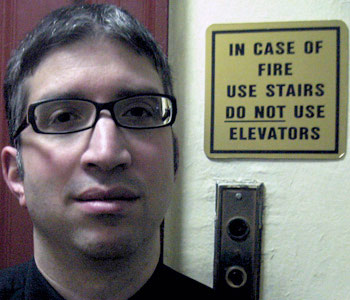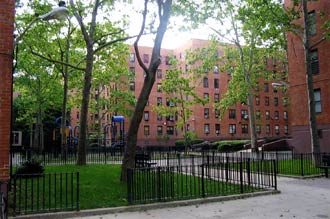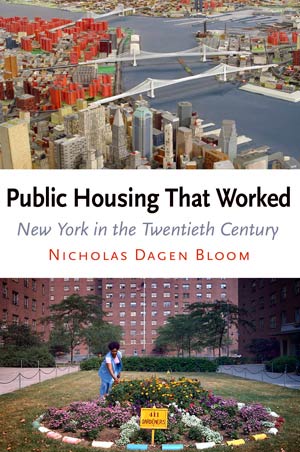
Public Housing That Worked is one of the few upbeat histories of one of the most reviled aspects of the American welfare state: tower block public housing. Some years ago I identified the curious fact that the projects of America’s largest housing authority had not suffered the same disastrous fate as so much public housing elsewhere. New York City still housed more than 10% of public housing tenants nationally, and its housing authority had been founded in 1934, but was mysteriously never the subject of a comprehensive history. Why not? Why had it been ignored? In my opinion the answer was simple: it did not fit the conventional wisdom that public housing is always doomed to failure. What I found, as I researched in the archives of the New York City Housing Authority, was that New York had adopted an alternative management model that proved superior to those in other cities. The book looks in detail, over time, at the different elements of this management including politics, design, tenant selection, community planning, and daily maintenance.
“If New York can keep up towers, why can’t many cities do a better job maintaining low-rise public housing?”
The fields of design and urban history are dominated by public housing enmity. Public housing projects are key proofs, for instance, in the theory that design determines social behavior. When New Urbanists, say, cite the superiority of their charming little villages like Seaside, Florida over suburban sprawl or urban renewal, they frequently mention public housing as a negative frame for their brave new world. The modernist superblocks and brick apartment buildings are viewed as ironclad guarantees of social and community failure. When urban historians want to show that politicians in the past acted unjustly, they also point to public housing towers as an example of social policy gone awry.
Time and again public housing is cited as an indicator of either design malfunction or social injustice. Even the destruction of public housing in recent years has become a framework for new injustice. Tenants, once thought to be suffering in public housing, are newly framed as victims losing community when they are forced by unfeeling administrators from their public housing homes.
Public Housing That Worked does not gloss over problems in cities such as Chicago or New Orleans—or New York for that matter. But the New York example allows for a more sophisticated discussion about the complex interrelationship of design, social context, and public policy.
Though New York’s towers have had and continue to have their share of problems, they make an interesting foil for traditional thinking about public housing. These towers have been preserved even under social stress and continue to house over 400,000 tenants in what are supposed to be completely unlivable environments. Could the design have been better and played a more positive role in the management today? Yes. But what makes New York so fascinating is that a mix of sometimes controversial social and management policies (including constant maintenance and tough policing) have gone a long way to keeping up thousands of public housing towers.
My book is rooted in a strange family history. My grandfather was head of the St. Louis Housing Authority in the 1960s when the most notorious example of public housing collapse took place. The Pruitt-Igoe towers in St. Louis had become unmanageable and during the 1960s became the most famous examples of social and design failure. My grandfather really wasn’t entirely to blame for the crisis—the towers were already in crisis when he took over—but his involvement with public housing always made the subject personal. My parents also moved in the 1990s across from Grant Houses, one of New York’s large public housing towers, and I was impressed how much better Grant Houses seemed than Pruitt-Igoe or other notorious projects. Wasn’t housing like this supposed to have been totally ruined by now? Finally, moving to New York to teach at the New York Institute of Technology made it possible to research and write the book at a rapid clip, as I could just get on the subway and go the archives of the Housing Authority at LaGuardia Community College as well as visit projects across the city.
Anybody interested in social policy should take a look at Chapters 11 and 12 in the book. These chapters show that New York’s housing managers faced and overcame many of the same social challenges that destroyed public housing in cities elsewhere—welfare concentration, crime, vandalism, etc. These chapters indicate that it wasn’t luck that kept New York’s towers alive, but the application of decent management practices even as the challenges mounted. During the most troubled years of the New York City Housing Authority, the 1970s and 1980s, employees still collected rents, mopped hallways, picked up trash, repaired elevators, arrested criminals, replaced broken windows, and cleaned graffiti—and they do so today.
New York’s public housing, both then and now, may not have been the utopia housing advocates dreamed up in the 1930s. But most people are surprised by how well kept New York’s public housing is, especially in light of all the negative press coverage public housing attracts. The buildings and grounds in New York are regularly maintained and the apartments much loved by long-term residents. Public housing in many other cities, meanwhile, has been completely abandoned by government officials.
Those who would abandon the poor by arguing that nothing can be done for them should consider the strategies of control and maintenance that, while not always popular or soft-hearted, kept public housing alive in New York. The old fashioned, often paternalistic, system of control pursued in New York has pretty progressive outcomes: lots of cheap housing for working people in one of the country’s most expensive cities.

“The old fashioned, often paternalistic, system of control pursued in New York has pretty progressive outcomes: lots of cheap housing for working people in one of the country’s most expensive cities.”
The book raises as many questions as it answers. If New York can keep up towers, why can’t many cities do a better job maintaining low-rise public housing? If New York can provide affordable housing on big scale, why can’t other cities and the federal government think about new subsidized housing? We probably will need more and better subsidized housing in the future; my book offers some lesson on what worked, not just what failed. Public Housing That Worked shows that ”smart” government can work for people and create decent social housing systems.
As we watch the collapse of the homeownership society—in part based on the idea that everyone regardless of income should own a home—I haven’t been surprised that public housing, with its negative reputation nationally, has stayed off the table as a solution to foreclosure. Yet I remain convinced that many people who moved into subprime housing would have been better off in some form of government subsidized housing in the first place. Instead of subsidizing these few families for billions, we let many working families buy houses they could not afford. This policy error will now cost us trillions as we try to stem foreclosure and steady the mortgage system. Frankly, I am not sure who will not live in some form of government subsidized housing when this crisis is finally over.


Nicholas Dagen Bloom is an associate professor and chairman of interdisciplinary studies at the New York Institute of Technology. He was born and raised in Baltimore and educated at the University of Wisconsin and Brandeis University. Besides Public Housing That Worked, he is the author of Suburban Alchemy: 1960s New Towns and the Transformation of the American Dream (2001) and Merchant of Illusion: James Rouse, America’s Salesman of the Businessman’s Utopia (2004), and editor of Adventures Into Mexico: American Tourism Beyond the Border (2006). Dr. Bloom has been an invited speaker on public housing history at Columbia University, the MIT, the New School University, and the New York City Housing Authority.